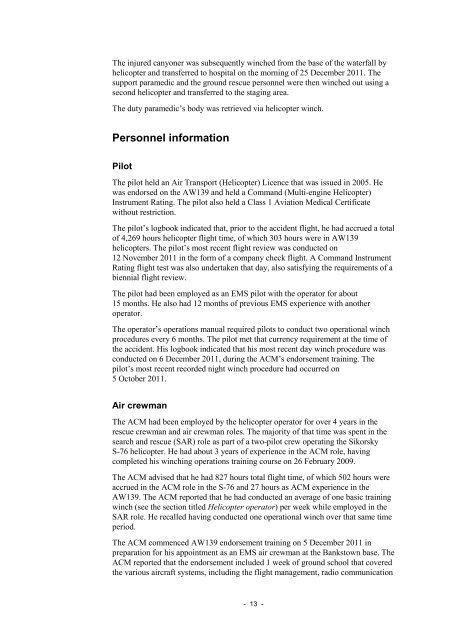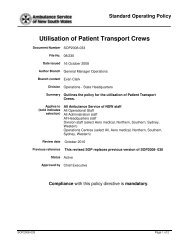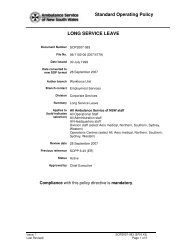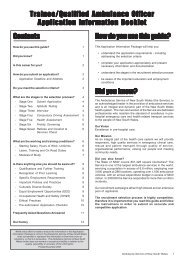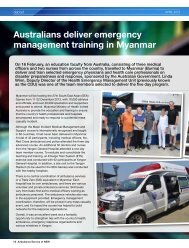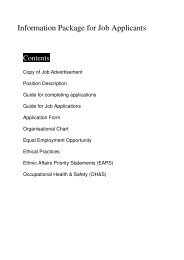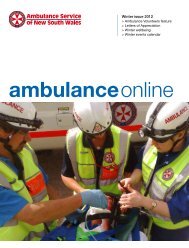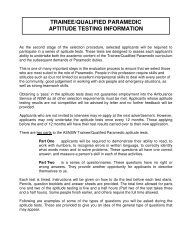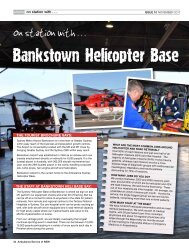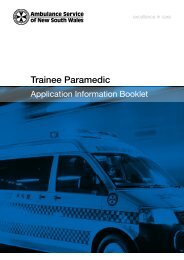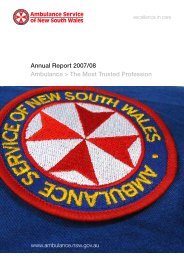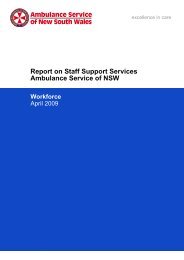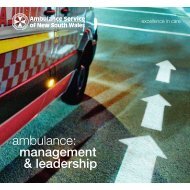atsb final report released 16 may 2013 - Ambulance Service of NSW
atsb final report released 16 may 2013 - Ambulance Service of NSW
atsb final report released 16 may 2013 - Ambulance Service of NSW
You also want an ePaper? Increase the reach of your titles
YUMPU automatically turns print PDFs into web optimized ePapers that Google loves.
The injured canyoner was subsequently winched from the base <strong>of</strong> the waterfall byhelicopter and transferred to hospital on the morning <strong>of</strong> 25 December 2011. Thesupport paramedic and the ground rescue personnel were then winched out using asecond helicopter and transferred to the staging area.The duty paramedic’s body was retrieved via helicopter winch.Personnel informationPilotThe pilot held an Air Transport (Helicopter) Licence that was issued in 2005. Hewas endorsed on the AW139 and held a Command (Multi-engine Helicopter)Instrument Rating. The pilot also held a Class 1 Aviation Medical Certificatewithout restriction.The pilot’s logbook indicated that, prior to the accident flight, he had accrued a total<strong>of</strong> 4,269 hours helicopter flight time, <strong>of</strong> which 303 hours were in AW139helicopters. The pilot’s most recent flight review was conducted on12 November 2011 in the form <strong>of</strong> a company check flight. A Command InstrumentRating flight test was also undertaken that day, also satisfying the requirements <strong>of</strong> abiennial flight review.The pilot had been employed as an EMS pilot with the operator for about15 months. He also had 12 months <strong>of</strong> previous EMS experience with anotheroperator.The operator’s operations manual required pilots to conduct two operational winchprocedures every 6 months. The pilot met that currency requirement at the time <strong>of</strong>the accident. His logbook indicated that his most recent day winch procedure wasconducted on 6 December 2011, during the ACM’s endorsement training. Thepilot’s most recent recorded night winch procedure had occurred on5 October 2011.Air crewmanThe ACM had been employed by the helicopter operator for over 4 years in therescue crewman and air crewman roles. The majority <strong>of</strong> that time was spent in thesearch and rescue (SAR) role as part <strong>of</strong> a two-pilot crew operating the SikorskyS-76 helicopter. He had about 3 years <strong>of</strong> experience in the ACM role, havingcompleted his winching operations training course on 26 February 2009.The ACM advised that he had 827 hours total flight time, <strong>of</strong> which 502 hours wereaccrued in the ACM role in the S-76 and 27 hours as ACM experience in theAW139. The ACM <strong>report</strong>ed that he had conducted an average <strong>of</strong> one basic trainingwinch (see the section titled Helicopter operator) per week while employed in theSAR role. He recalled having conducted one operational winch over that same timeperiod.The ACM commenced AW139 endorsement training on 5 December 2011 inpreparation for his appointment as an EMS air crewman at the Bankstown base. TheACM <strong>report</strong>ed that the endorsement included 1 week <strong>of</strong> ground school that coveredthe various aircraft systems, including the flight management, radio communication- 13 -


